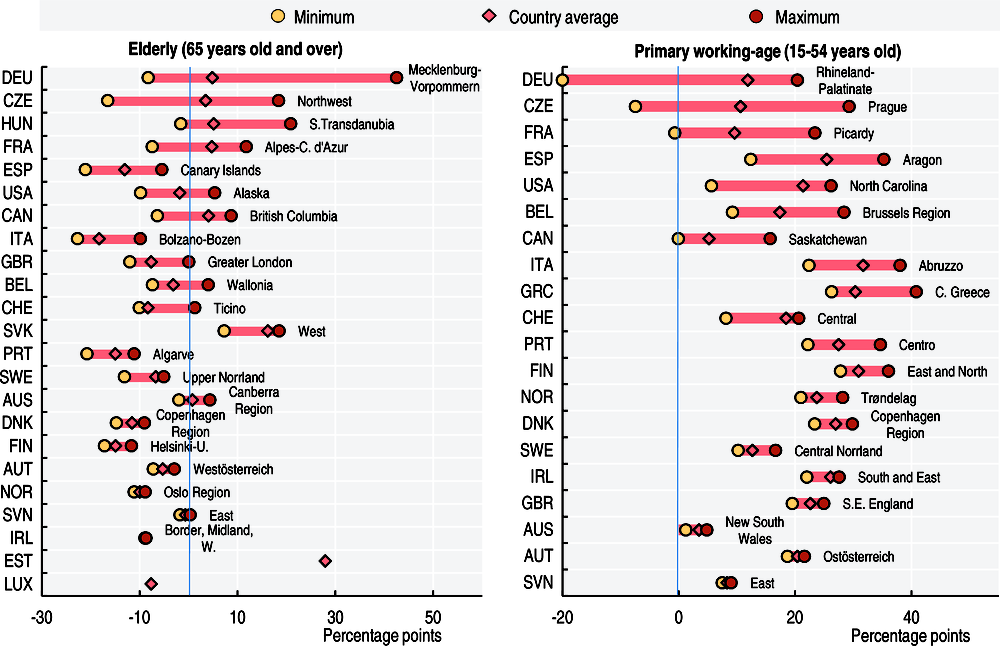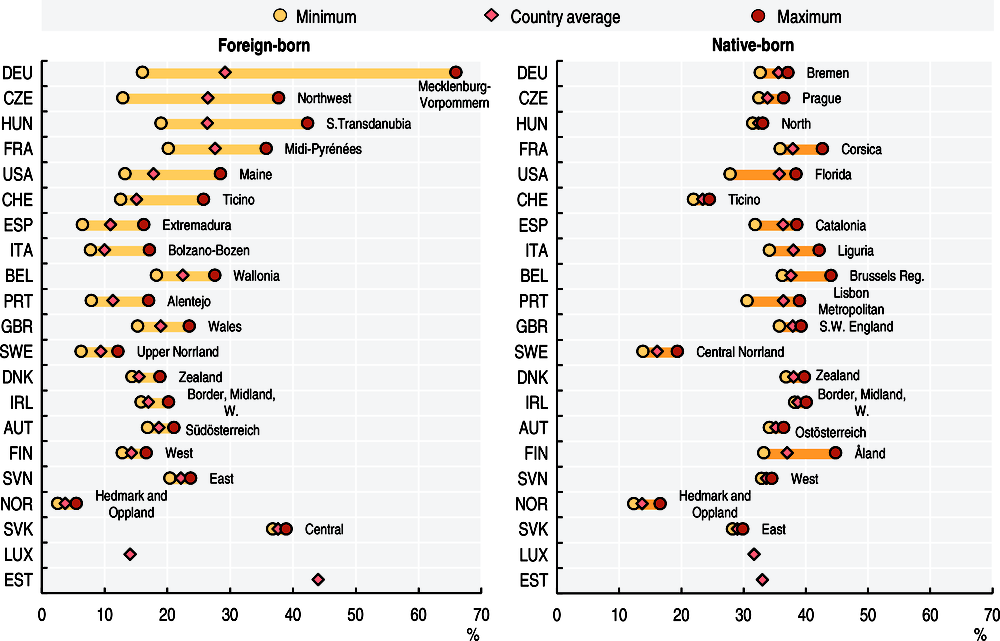Foreign-born population by age and dependency ratios in regions
With larger proportions of people in their early working age, migration is mitigating the ageing of population in most regions.
In a context of ageing societies in many OECD countries, migration often provides a source of working-age population. Across OECD regions, the share of foreign-born population of primary working age – between 14 and 54 years old – tends to be larger than its native-born counterpart. Figure 3.17 shows that migrants are overrepresented compared with the native-born in this age-group in practically all regions, with exceptions in Germany (Thuringia, Mecklenburg-Vorpommern, Saxony-Anhalt, Brandenburg, and Saxony), Czech Republic (Moravia-Silesia), France (Midi-Pyrénées) and Canada (Nova Scotia). In eight out of the twenty countries covered, this positive difference is of at least 15 percentage points. However, in Germany, Czech Republic, and France, regions with high proportions of primary working age population among migrants coexist with regions where the same proportion is higher among native born.
The elderly population rate for the native-born is higher than that for the foreign-born in 70% of the regions covered in Figure 3.17. What is more, in all regions of Finland, Portugal, Italy, Denmark, Norway, Ireland, Spain, Sweden, and Austria the shares of elderly native-born population are always higher than those displayed by the foreign-born. Nevertheless, this reality is not homogeneous across regions; for instance, in more than one-third of the regions of Slovak Republic, Germany and Czech Republic, the difference between the shares of elderly foreign- and native-born population is above 10 percentage points.
The terms “foreign-born” and “migrants” are used interchangeably. Migrants are defined by place of birth. The foreign-born or migrant population is defined as the population born in a country different from the one of residence. Unlike citizenship, this criterion does not change over time, it is not subject to country differences in legislation and it is thus adequate for international comparisons.
The primary working-age population refers to the 25-54 year old population, while the elderly population refers to the population aged 65 years and over. The dependency ratio is defined as the ratio between the elderly (65 years old and over) and the young population (14 years old or younger) over the whole population.
Dependency ratios provide a rough indication of the potential pressure on the regional transfer systems due to the share of the economically dependent population, i.e. mostly children (14 years old or less) and the elderly (65 years old or over). When looking at this indicator by place of origin, regional dependency ratios of the native-born appear to be higher than those of the foreign-born for 93% of the regions covered. In all countries except Germany, Estonia, Hungary, the Slovak Republic, Czech Republic, the United States, and Switzerland, regional dependency ratios of the native-born are higher than those of the foreign-born. Nonetheless, within-country disparities in dependency ratios are higher for the foreign-born than for their native counterparts. While the elderly dependency ratio for the foreign-born differs on average by 12 percentage points within OECD countries, for the native born this difference is on average 5 percentage points (Figure 3.18).
Source
OECD (2018), OECD Regional Statistics (database), https://doi.org/10.1787/region-data-en.
See Annex B for data sources and country-related metadata.
Reference years and territorial level
2015; 2014-2015 (two-year average) for European countries and US; TL2, except for Austria, where data is only available at the NUTS1 level.
Further information
Territorial grids and regional typology (Annex A)
Diaz Ramirez, M., et al. (2018), “The integration of migrants in OECD regions: A first assessment”, OECD Regional Development Working Papers, No. 2018/01, OECD Publishing, Paris, https://doi.org/10.1787/fb089d9a-en.
Figure notes
3.17: Percentage of respective place-of-birth population. Differences between foreign- and native-born.
3.18: Percentage of respective place-of-birth working-age population.


